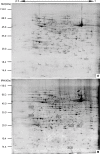Proteomic analysis of gametophytic sex expression in the fern Ceratopteris thalictroides
- PMID: 31425560
- PMCID: PMC6699692
- DOI: 10.1371/journal.pone.0221470
Proteomic analysis of gametophytic sex expression in the fern Ceratopteris thalictroides
Abstract
Ceratopteris thalictroides, a model fern, has two kinds of gametophytes with different sex expression: male and hermaphrodite. Hermaphroditic gametophytes have one or several archegonia beneath the growing point and a few antheridia at the base or margin. Male gametophytes show a spoon-like shape with much longer than the width and produce many antheridia at the margin and surface. The results of chlorophyll fluorescence detection showed that the photochemical efficiency of hermaphrodites was higher than that of males. By using two-dimensional electrophoresis and mass spectrometry, the differentially abundant proteins in hermaphroditic and male gametophytes were identified. A total of 1136 ± 55 protein spots were detected in Coomassie-stained gels of proteins from hermaphroditic gametophytes, and 1130 ± 65 spots were detected in gels of proteins from male gametophytes. After annotation, 33 spots representing differentially abundant proteins were identified. Among these, proteins involved in photosynthesis and chaperone proteins were over-represented in hermaphrodites, whereas several proteins involved in metabolism were increased in male gametophytes in order to maintain their development under relatively nutritionally deficient conditions. Furthermore, the differentially abundant cytoskeletal proteins detected in this study, such as centrin and actin, may be involved in the formation of sexual organs and are directly related to sex expression. These differentially abundant proteins are important for maintaining the development of gametophytes of different sexes in C. thalictroides.
Conflict of interest statement
The authors have declared that no competing interests exist.
Figures




References
-
- Korpelainen H. Labile sex expression in plants. Biological Reviews. 1998;73(2):157–80. 10.1111/j.1469-185X.1997.tb00028.x - DOI
Publication types
MeSH terms
Substances
LinkOut - more resources
Full Text Sources

